Abdulkadir Celik
Joint Motion, Angle, and Range Estimation in Near-Field under Array Calibration Imperfections
Jul 17, 2025Abstract:Ultra-massive multiple-input multiple-output MIMO (UM-MIMO) leverages large antenna arrays at high frequencies, transitioning communication paradigm into the radiative near-field (NF), where spherical wavefronts enable full-vector estimation of both target location and velocity. However, location and motion parameters become inherently coupled in this regime, making their joint estimation computationally demanding. To overcome this, we propose a novel approach that projects the received two-dimensional space-time signal onto the angle-Doppler domain using a two-dimensional discrete Fourier transform (2D-DFT). Our analysis reveals that the resulting angular spread is centered at the target's true angle, with its width determined by the target's range. Similarly, transverse motion induces a Doppler spread centered at the true radial velocity, with the width of Doppler spread proportional to the transverse velocity. Exploiting these spectral characteristics, we develop a low-complexity algorithm that provides coarse estimates of angle, range, and velocity, which are subsequently refined using one-dimensional multiple signal classification (MUSIC) applied independently to each parameter. The proposed method enables accurate and efficient estimation of NF target motion parameters. Simulation results demonstrate a normalized mean squared error (NMSE) of -40 dB for location and velocity estimates compared to maximum likelihood estimation, while significantly reducing computational complexity.
Analyzing URA Geometry for Enhanced Spatial Multiplexing and Extended Near-Field Coverage
Jun 18, 2025Abstract:With the deployment of large antenna arrays at high frequency bands, future wireless communication systems are likely to operate in the radiative near-field. Unlike far-field beam steering, near-field beams can be focused within a spatial region of finite depth, enabling spatial multiplexing in both the angular and range dimensions. This paper derives the beamdepth for a generalized uniform rectangular array (URA) and investigates how array geometry influences the near-field beamdepth and the limits where near-field beamfocusing is achievable. To characterize the near-field boundary in terms of beamfocusing and spatial multiplexing gains, we define the effective beamfocusing Rayleigh distance (EBRD) for a generalized URA. Our analysis reveals that while a square URA achieves the narrowest beamdepth, the EBRD is maximized for a wide or tall URA. However, despite its narrow beamdepth, a square URA may experience a reduction in multiuser sum rate due to its severely constrained EBRD. Simulation results confirm that a wide or tall URA achieves a sum rate of 3.5 X more than that of a square URA, benefiting from the extended EBRD and improved spatial multiplexing capabilities.
Near-Field Beam Prediction Using Far-Field Codebooks in Ultra-Massive MIMO Systems
Mar 18, 2025Abstract:Ultra-massive multiple-input multiple-output (UM-MIMO) technology is a key enabler for 6G networks, offering exceptional high data rates in millimeter-wave (mmWave) and Terahertz (THz) frequency bands. The deployment of large antenna arrays at high frequencies transitions wireless communication into the radiative near-field, where precise beam alignment becomes essential for accurate channel estimation. Unlike far-field systems, which rely on angular domain only, near-field necessitates beam search across both angle and distance dimensions, leading to substantially higher training overhead. To address this challenge, we propose a discrete Fourier transform (DFT) based beam alignment to mitigate the training overhead. We highlight that the reduced path loss at shorter distances can compensate for the beamforming losses typically associated with using far-field codebooks in near-field scenarios. Additionally, far-field beamforming in the near-field exhibits angular spread, with its width determined by the user's range and angle. Leveraging this relationship, we develop a correlation interferometry (CI) algorithm, termed CI-DFT, to efficiently estimate user angle and range parameters. Simulation results demonstrate that the proposed scheme achieves performance close to exhaustive search in terms of achievable rate while significantly reducing the training overhead by 87.5%.
Near-Field ISAC: Synergy of Dual-Purpose Codebooks and Space-Time Adaptive Processing
Jan 15, 2025



Abstract:Integrated sensing and communication (ISAC) has emerged as a transformative paradigm, enabling situationally aware and perceptive next-generation wireless networks through the co-design of shared network resources. With the adoption of millimeter-wave (mmWave) and terahertz (THz) frequency bands, ultra-massive MIMO (UM-MIMO) systems and holographic surfaces unlock the potential of near-field (NF) propagation, characterized by spherical wavefronts that facilitate beam manipulation in both angular and range domains. This paper presents a unified approach to near-field beam-training and sensing, introducing a dual-purpose codebook design that employs discrete Fourier transform (DFT)-based codebooks for coarse estimation of sensing parameters and polar codebooks for parameter refinement. Leveraging these range and angle estimates, a customized low-complexity space-time adaptive processing (STAP) technique is proposed for NF-ISAC to detect slow-moving targets and efficiently mitigate clutter. The interplay between codebooks and NF-STAP framework offers three key advantages: reduced communication beam training overhead, improved estimation accuracy, and minimal STAP computational complexity. Simulation results show that the proposed framework can reduce STAP complexity by three orders of magnitude, validating efficacy, and highlighting the potential of the proposed approach to seamlessly integrate NF communication and sensing functionalities in future wireless networks.
NetOrchLLM: Mastering Wireless Network Orchestration with Large Language Models
Dec 13, 2024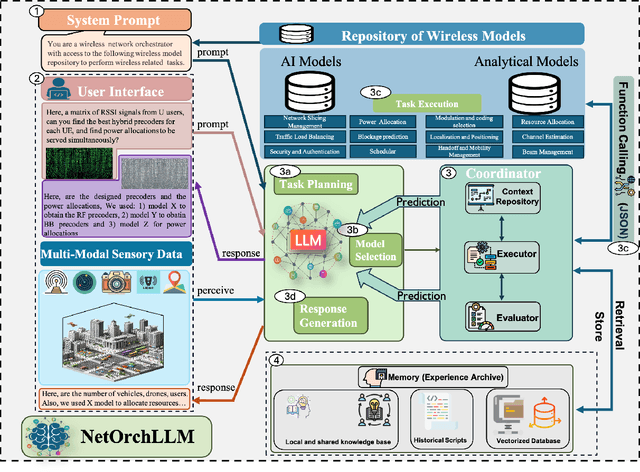



Abstract:The transition to 6G networks promises unprecedented advancements in wireless communication, with increased data rates, ultra-low latency, and enhanced capacity. However, the complexity of managing and optimizing these next-generation networks presents significant challenges. The advent of large language models (LLMs) has revolutionized various domains by leveraging their sophisticated natural language understanding capabilities. However, the practical application of LLMs in wireless network orchestration and management remains largely unexplored. Existing literature predominantly offers visionary perspectives without concrete implementations, leaving a significant gap in the field. To address this gap, this paper presents NETORCHLLM, a wireless NETwork ORCHestrator LLM framework that uses LLMs to seamlessly orchestrate diverse wireless-specific models from wireless communication communities using their language understanding and generation capabilities. A comprehensive framework is introduced, demonstrating the practical viability of our approach and showcasing how LLMs can be effectively harnessed to optimize dense network operations, manage dynamic environments, and improve overall network performance. NETORCHLLM bridges the theoretical aspirations of prior research with practical, actionable solutions, paving the way for future advancements in integrating generative AI technologies within the wireless communications sector.
Hybrid Beamforming for Integrated Sensing and Communications With Low Resolution DACs
Nov 05, 2024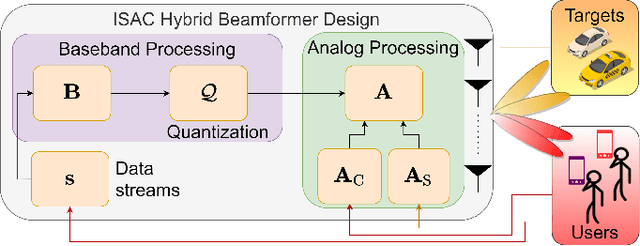
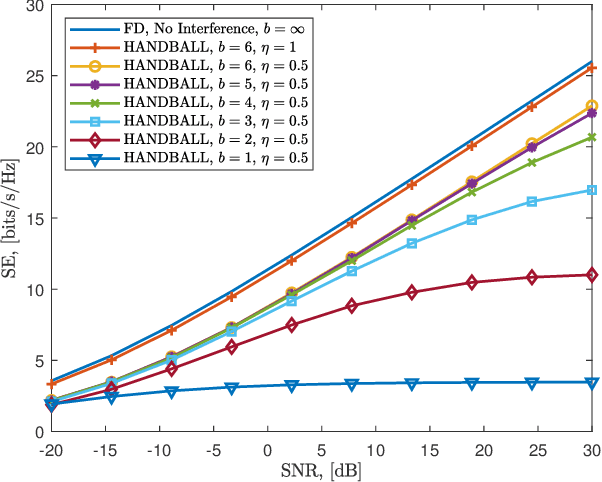
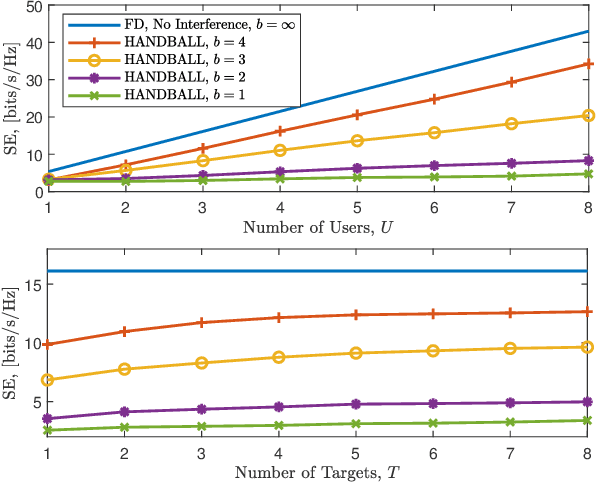
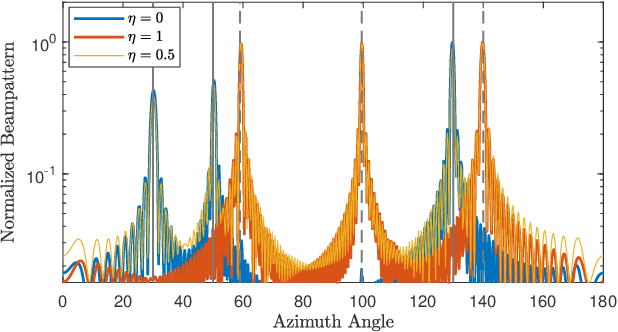
Abstract:Integrated sensing and communications (ISAC) has emerged as a means to efficiently utilize spectrum and thereby save cost and power. At the higher end of the spectrum, ISAC systems operate at wideband using large antenna arrays to meet the stringent demands for high-resolution sensing and enhanced communications capacity. On the other hand, the overall design should satisfy energy-efficiency and hardware constraints such as operating on low resolution components for a practical scenario. Therefore, this paper presents the design of Hybrid ANalog and Digital BeAmformers with Low resoLution (HANDBALL) digital-to-analog converters (DACs). We introduce a greedy-search-based approach to design the analog beamformers for multi-user multi-target ISAC scenario. Then, the quantization distortion is taken into account in order to design the baseband beamformer with low resolution DACs. We evaluated performance of the proposed HANDBALL technique in terms of both spectral efficiency and sensing beampattern, providing a satisfactory sensing and communication performance for both one-bit and few-bit designs.
The Curse of Beam-Squint in ISAC: Causes, Implications, and Mitigation Strategies
Jun 05, 2024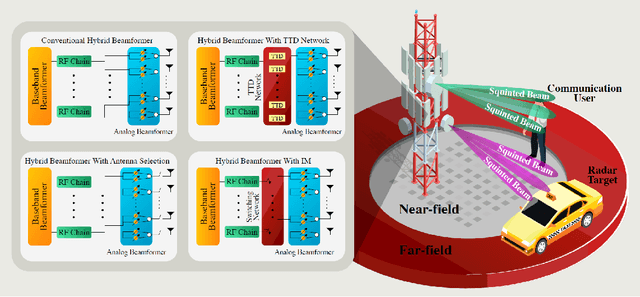
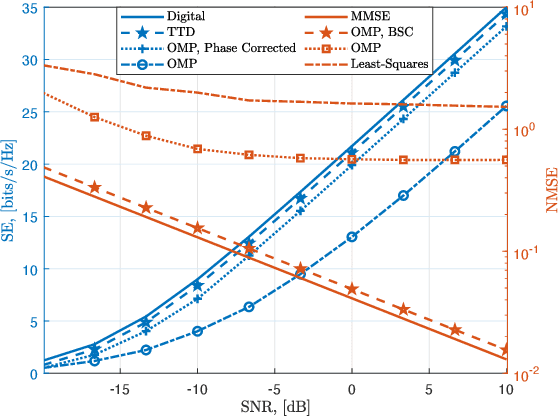
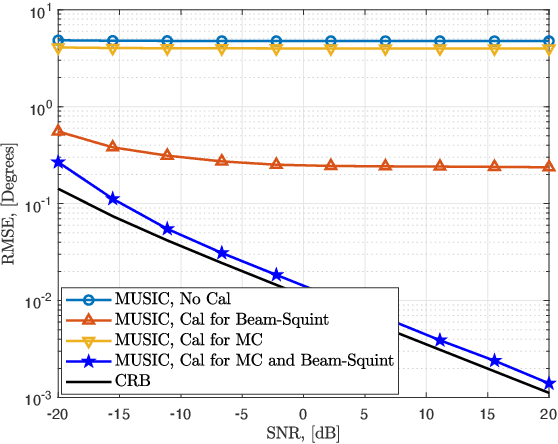
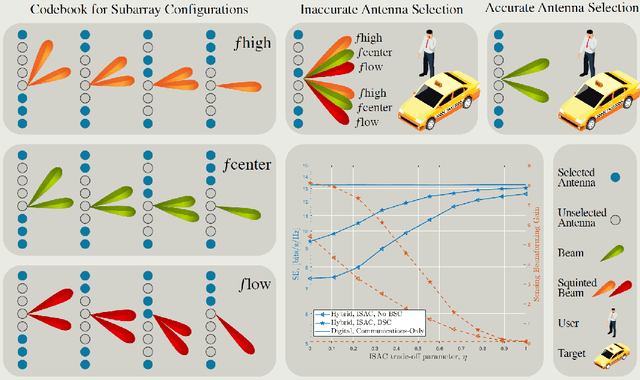
Abstract:Integrated sensing and communications (ISAC) has emerged as a means to efficiently utilize spectrum and thereby save cost and power. At the higher end of the spectrum, ISAC systems operate at wideband using large antenna arrays to meet the stringent demands for high-resolution sensing and enhanced communications capacity. However, the wideband implementation entails beam-squint, that is, deviations in the generated beam directions because of the narrowband assumption in the analog components. This causes significant degradation in the communications capacity, target detection, and parameter estimation. This article presents the design challenges caused by beam-squint and its mitigation in ISAC systems. In this context, we also discuss several ISAC design perspectives including far-/near-field beamforming, channel/direction estimation, sparse array design, and index modulation. There are also several research opportunities in waveform design, beam training, and array processing to adequately address beam-squint in ISAC.
Index Modulation for Integrated Sensing and Communications: A Signal Processing Perspective
Jan 16, 2024



Abstract:A joint design of both sensing and communication can lead to substantial enhancement for both subsystems in terms of size, cost as well as spectrum and hardware efficiency. In the last decade, integrated sensing and communications (ISAC) has emerged as a means to efficiently utilize the spectrum on a single and shared hardware platform. Recent studies focused on developing multi-function approaches to share the spectrum between radar sensing and communications. Index modulation (IM) is one particular approach to incorporate information-bearing communication symbols into the emitted radar waveforms. While IM has been well investigated in communications-only systems, the implementation adoption of IM concept in ISAC has recently attracted researchers to achieve improved energy/spectral efficiency while maintaining satisfactory radar sensing performance. This article focuses on recent studies on IM-ISAC, and presents in detail the analytical background and relevance of the major IM-ISAC applications.
NEAT-MUSIC: Auto-calibration of DOA Estimation for Terahertz-Band Massive MIMO Systems
Nov 07, 2023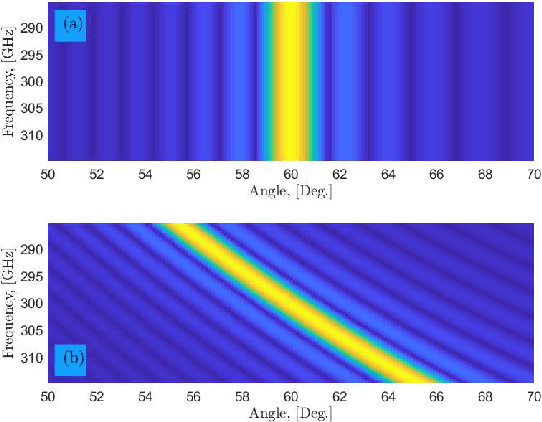
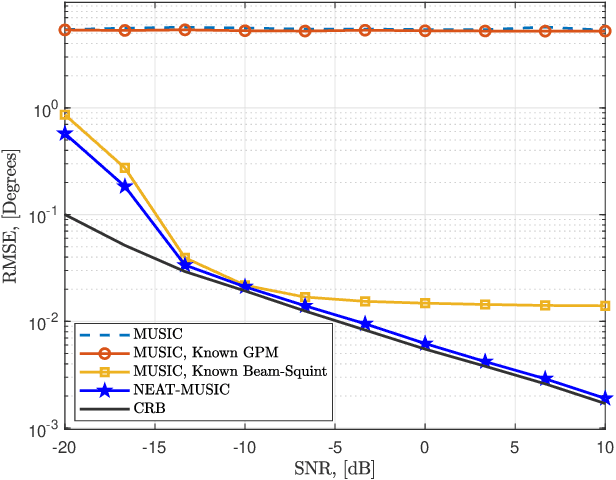
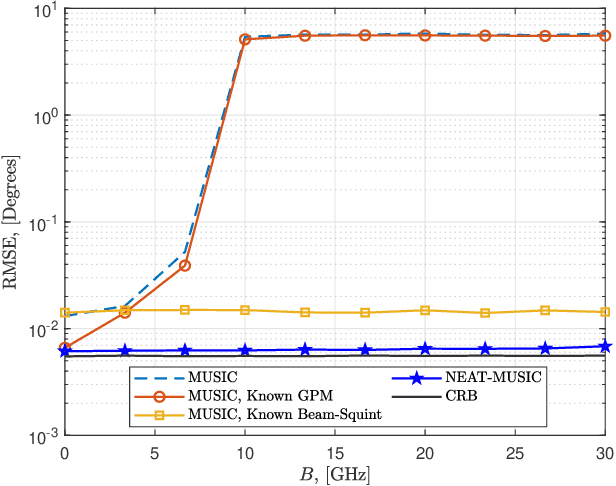

Abstract:Terahertz (THz) band is envisioned for the future sixth generation wireless systems thanks to its abundant bandwidth and very narrow beamwidth. These features are one of the key enabling factors for high resolution sensing with milli-degree level direction-of-arrival (DOA) estimation. Therefore, this paper investigates the DOA estimation problem in THz systems in the presence of two major error sources: 1) gain-phase mismatches, which occur due to the deviations in the radio-frequency circuitry; 2) beam-squint, which is caused because of the deviations in the generated beams at different subcarriers due to ultra-wide bandwidth. An auto-calibration approach, namely NoisE subspAce correcTion technique for MUltiple SIgnal Classification (NEAT-MUSIC), is proposed based on the correction of the noise subspace for accurate DOA estimation in the presence of gain-phase mismatches and beam-squint. To gauge the performance of the proposed approach, the Cramer-Rao bounds are also derived. Numerical results show the effectiveness of the proposed approach.
Near-field Hybrid Beamforming for Terahertz-band Integrated Sensing and Communications
Sep 25, 2023Abstract:Terahertz (THz) band communications and integrated sensing and communications (ISAC) are two main facets of the sixth generation wireless networks. In order to compensate the severe attenuation, the THz wireless systems employ large arrays, wherein the near-field beam-squint severely degrades the beamforming accuracy. Contrary to prior works that examine only either narrowband ISAC beamforming or far-field models, we introduce an alternating optimization technique for hybrid beamforming design in near-field THz-ISAC scenario. We also propose an efficient approach to compensate near-field beam-squint via baseband beamformers. Via numerical simulations, we show that the proposed approach achieves satisfactory spectral efficiency performance while accurately estimating the near-field beamformers and mitigating the beam-squint without additional hardware components.
 Add to Chrome
Add to Chrome Add to Firefox
Add to Firefox Add to Edge
Add to Edge